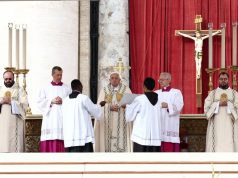
The London-born Italian teenager Carlo Acutis is likely to become the first “millennial saint” after two miracles attributed to him were recognized by Pope Francis.
READ: Carlo Acutis to be first millennial saint: Pope Francis recognizes miracle for canonization
Spending most of his life in Milan, Acutis was an incredibly devout Catholic who went on regular pilgrimages across Europe. He had a desire to attend mass daily and regularly pray the rosary – but he also loved playing video games and teaching himself computer coding and animation.
Aged only 15, Acutis was diagnosed with untreatable leukemia. He died in 2006 and was eventually buried in Assisi.
The cause for his canonization started in 2013 and he was designated “venerable” in 2018, a term which recognizes that an individual was “heroic in virtue” through their actions during their lifetime. After the approval of the first miracle – the healing of a Brazilian child’s pancreas after the boy venerated (prayed to and revered) one of Acutis’s relics – he was declared “blessed” in 2020 at the Basilica of Saint Francis of Assisi.
A year earlier, Acutis’s remains had been moved to the Church of Santa Maria Maggiore in Assisi, where his body and relics have been on display ever since. An official livestream is witness to the constant flow of pilgrims that visit him. The second miracle attributed to Acutis, in 2022, saw a woman from Costa Rica recover from severe head trauma and craniotomy surgery despite her chance of survival being incredibly low.
Speaking about Acutis in 2020, Pope Francis discussed the characteristics of the youngster that he admired – values that were to be aspired to by all Catholics, especially younger ones.
According to the pope, Acutis did not “ease into comfortable immobilism” during his lifetime, but rather “understood the needs of his time” and adapted, while still believing that “true happiness is found by putting God in first place”. This statement could serve as a summary of the pope’s own attitude to change and adaptation within the church, in its engagement with the modern world.
The new potential saint aligns with the church’s ongoing approach to issues around AI, science and technology, which the pope has insisted must be used at the service of human dignity and human development.
In 2019, a landmark workshop by the Pontifical Academy for Life gathered scientists, ethicists and theologians together in Rome to discuss the future of robotics. Since then, the pope has continued this progressive approach, supporting schemes encouraging children to get into computer programming and becoming the first pope to write a line of code.
Having a young, digitally “switched on” saint brings a new emphasis to Catholic teaching on young people’s engagement with the internet and the digital world more broadly.
When Pope Francis wrote about the potential dangers of technology and social media in his exhortation Christus Vivit in 2019, he referred to Acutis as an example of a young person who “knew how to use the new communications technology to transmit the Gospel, to communicate values and beauty”. Such remarks show both the openness of the church to engage with these platforms, and the caution it believes younger generations still need to apply to their digital lives.
During his lifetime, Acutis created a website cataloguing every reported Eucharistic miracle in the world, and every approved apparition of the Virgin Mary. After his death, a travelling exhibition based on this catalogue has visited dozens of countries. It is this blend of digital communication and traditional Catholic teaching and morality that the church will be keen to foster in future generations.
The canonizations of saints can often be a signifier of change and renewal within the church. In 1622, for example, there was a bumper crop of canonizations: Francis Xavier (1506-1552), Ignatius of Loyola (1491-1556), Teresa of Avila (1515-1582), and Philip Neri (1515-1595). These were characteristic of the strength of a renewed Catholicism after the challenge of the Protestant Reformation.
Acutis’s potential canonization could be the beginning of a new era in a church dealing with the challenges of the digital age. But he is not a saint just yet.
Pope Francis will first convene a consistory of cardinals to deliberate the canonization. Once approved, a date can be set for a mass of canonization and thereafter, the official acknowledgement of sainthood throughout the Catholic church – at which point, Acutis will become a model of holiness in a digital age.![]()
Liam Temple, Capuchin Fellow in the History of Catholicism, Durham University. This article is republished from The Conversation under a Creative Commons license. Read the original article.









